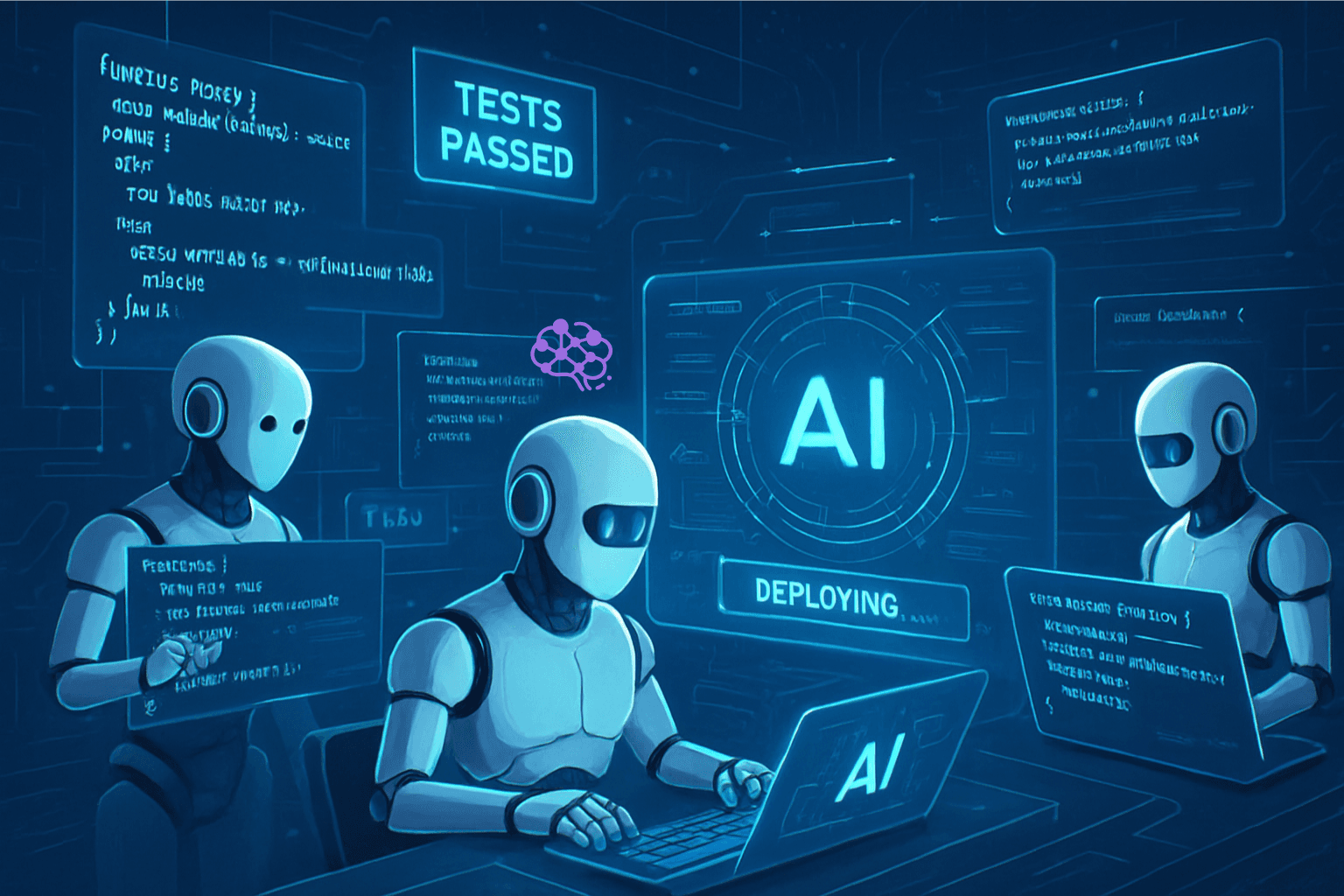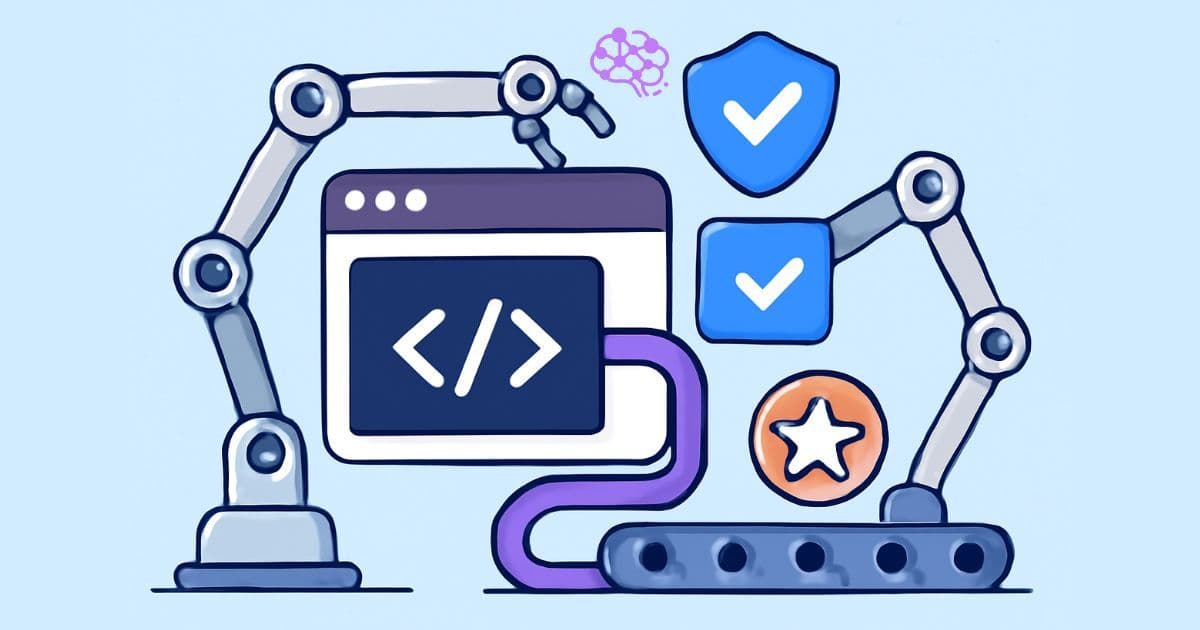
The software development landscape is experiencing a paradigmatic shift as agentic AI systems emerge to handle complex development tasks with minimal human intervention. Unlike traditional AI tools that require constant guidance, agentic AI operates autonomously, making decisions, writing code, running tests, and deploying applications independently.
This revolutionary approach to software development represents the evolution from keyword stuffing to autonomous optimization, where AI systems understand intricate relationships between various development factors and make decisions based on a holistic view of the entire software lifecycle.
What is Agentic AI in Software Development?
Agentic AI describes AI systems designed to autonomously make decisions and act, with the ability to pursue complex goals with limited supervision. In software development contexts, these systems can break down complex tasks, plan solutions, and execute development workflows without human intervention.
The key differentiator between agentic AI and traditional generative AI lies in autonomous decision-making capabilities. While generative AI creates content based on prompts, agentic AI can:
- Analyze requirements and break them into actionable development tasks
- Make architectural decisions based on project constraints and best practices
- Execute multi-step workflows including coding, testing, and deployment
- Adapt strategies in real-time based on feedback and changing requirements
- Learn from failures and adjust approaches accordingly
Core Components of Agentic AI Systems
Modern agentic AI systems in software development comprise several interconnected components:
Autonomous Code Generation and Development
Intelligent Code Architecture
Agentic AI systems excel at creating well-structured, maintainable code by analyzing project requirements and making informed architectural decisions. These systems can:
Generate Multi-Language Applications: Modern agentic AI can work across different programming languages and frameworks simultaneously, creating full-stack applications with consistent architecture patterns.
Adaptive Design Patterns: Agentic AI systems analyze project requirements and automatically apply appropriate design patterns, ensuring scalability and maintainability without human intervention.
Real-Time Code Optimization
One of the most powerful aspects of agentic AI in development is its ability to continuously optimize code performance. These systems monitor application behavior and automatically refactor code for better efficiency:
- Performance bottleneck identification and automatic resolution
- Memory usage optimization through intelligent caching strategies
- Database query optimization based on actual usage patterns
- Security vulnerability detection and automatic patching
Autonomous Testing and Quality Assurance
Comprehensive Test Generation
Agentic AI revolutionizes software testing by generating comprehensive test suites that cover edge cases human developers might overlook. The AI analyzes code paths, identifies potential failure points, and creates targeted tests:
Automated Integration Testing
Agentic AI systems create integration tests that verify system behavior across multiple components, automatically updating tests when system architecture changes:
- API endpoint validation with realistic data scenarios
- Database integrity checks across transactions
- Cross-service communication testing in microservice architectures
- Performance benchmarking with automated threshold monitoring
Autonomous Deployment and DevOps
Infrastructure as Code Generation
Agentic AI systems analyze application requirements and automatically generate infrastructure configurations optimized for the specific use case:
Continuous Integration/Continuous Deployment (CI/CD)
Agentic AI manages the entire CI/CD pipeline, making real-time adjustments based on deployment success rates, performance metrics, and user feedback. The system can:
Automatically optimize build processes by analyzing build times and identifying bottlenecks
Implement progressive deployment strategies such as blue-green deployments or canary releases
Monitor application health and automatically rollback deployments if issues are detected
Scale infrastructure dynamically based on traffic patterns and resource utilization
Industry Applications and Use Cases
Enterprise Software Development
Large enterprises are leveraging agentic AI to accelerate development cycles and reduce technical debt. These systems can analyze legacy codebases and automatically modernize applications while maintaining functionality:
- Legacy system migration with automated code translation
- Microservices decomposition from monolithic applications
- Security compliance automation ensuring applications meet regulatory requirements
- Documentation generation that stays synchronized with code changes
Startup and SME Development
Smaller organizations benefit from agentic AI's ability to provide enterprise-level development capabilities without requiring large development teams:
Open Source Contribution
Agentic AI is transforming open source development by automatically identifying bugs, generating fixes, and submitting pull requests. This creates a self-improving ecosystem where software quality continuously increases without human intervention.
Technical Implementation Strategies
Getting Started with Agentic AI Development
Implementing agentic AI in your development workflow requires careful planning and gradual integration. Here's a practical roadmap:
Phase 1: Assessment and Preparation
Evaluate Current Development Processes: Analyze existing workflows to identify repetitive tasks that can be automated. Focus on areas where consistency and speed improvements would have the highest impact.
Infrastructure Requirements: Ensure your development environment can support AI-powered tools. This includes adequate computational resources and API integrations with AI platforms.
Phase 2: Pilot Implementation
Start with low-risk, high-impact areas such as:
- Automated code review and style enforcement
- Test case generation for existing functions
- Documentation updates based on code changes
- Simple bug fixes in non-critical components
Phase 3: Advanced Integration
Once comfortable with basic automation, expand to more complex tasks:
Integration with Existing Development Tools
Successful agentic AI implementation requires seamless integration with existing development ecosystems:
Version Control Integration: AI agents work directly with Git repositories, creating meaningful commit messages, managing branches, and handling merge conflicts automatically.
IDE Extensions: Modern agentic AI provides real-time suggestions and autonomous code completion that goes beyond simple autocomplete to understand project context and generate complex functions.
Project Management Integration: AI systems can automatically update project boards, estimate task completion times, and allocate resources based on team capacity and project priorities.
Challenges and Considerations
Technical Challenges
While agentic AI offers tremendous capabilities, several technical challenges must be addressed:
Code Quality and Consistency: Ensuring AI-generated code meets organizational standards requires comprehensive configuration and continuous monitoring. Organizations must establish clear coding guidelines and validation frameworks.
Security Implications: Autonomous code generation introduces new security considerations. AI systems must be trained to follow security best practices and undergo regular security audits to prevent vulnerabilities.
Debugging and Maintenance: When AI-generated code fails, developers need tools and methodologies to understand and fix issues efficiently. This requires new debugging approaches and comprehensive logging systems.

Organizational Adaptation
Skill Development Requirements: Development teams need training on how to work effectively with agentic AI systems. This includes understanding AI capabilities, limitations, and best practices for human-AI collaboration.
Process Integration: Organizations must adapt existing development processes to accommodate autonomous AI agents while maintaining quality control and compliance requirements.
Cultural Change Management: Successful adoption requires addressing developer concerns about job displacement and emphasizing how AI augments rather than replaces human creativity and problem-solving skills.
Future Trends and Predictions
Evolution Toward Full Autonomy
The trajectory of agentic AI in software development points toward increasingly autonomous systems capable of handling entire project lifecycles. By 2026, we can expect:
Project Management Automation: AI systems will autonomously manage project timelines, resource allocation, and stakeholder communication based on project complexity and team capacity.
Architectural Decision Making: Advanced AI will make sophisticated architectural decisions, considering factors like scalability requirements, performance constraints, and budget limitations.
Cross-Platform Development: Agentic AI will seamlessly develop applications across web, mobile, and desktop platforms using unified development approaches.
Integration with Emerging Technologies
Quantum Computing Integration: As quantum computing becomes more accessible, agentic AI will automatically optimize applications for quantum architectures, handling the complex mathematics and error correction required.
Edge Computing Optimization: AI systems will automatically distribute application components between edge devices and cloud infrastructure for optimal performance and cost efficiency.
Blockchain and Web3 Development: Agentic AI will streamline smart contract development, automatically implementing security best practices and optimizing gas efficiency.
Best Practices for Implementation
Development Team Preparation
Establish AI Governance Framework: Create clear guidelines for AI system behavior, including quality gates, security requirements, and escalation procedures for complex decisions.
Implement Comprehensive Monitoring: Deploy monitoring systems that track AI performance, code quality metrics, and system reliability to ensure autonomous operations meet organizational standards.
Create Feedback Loops: Establish mechanisms for continuous improvement where AI systems learn from deployment outcomes and user feedback to enhance future performance.
Technical Infrastructure Requirements
Organizations planning to implement agentic AI development systems should prepare infrastructure that supports:
- High-performance computing resources for real-time code analysis and generation
- Robust API management for integration with multiple AI services and development tools
- Comprehensive data storage for training data, code repositories, and performance metrics
- Security frameworks specifically designed for AI-powered development environments
ROI and Business Impact
Quantifiable Benefits
Organizations implementing agentic AI in software development report significant measurable improvements:
Development Speed: Teams experience 300-500% faster development cycles for routine features and bug fixes, allowing focus on complex problem-solving and innovation.
Code Quality Consistency: Automated code generation eliminates human inconsistencies, resulting in 40-60% fewer bugs in production systems.
Resource Optimization: Autonomous systems optimize infrastructure usage, typically reducing operational costs by 25-40% through intelligent resource allocation and scaling.
Long-term Strategic Advantages
Competitive Differentiation: Early adopters of agentic AI gain significant market advantages through faster product iterations and improved software quality.
Talent Attraction: Organizations with advanced AI-powered development environments attract top-tier developers interested in working with cutting-edge technology.
Scalability Without Proportional Costs: Agentic AI enables organizations to scale development output without proportionally increasing team size, improving profitability and operational efficiency.
Conclusion
Agentic AI represents a fundamental transformation in software development, moving beyond traditional AI assistance to truly autonomous systems capable of handling complex development tasks independently. These systems are not just tools but collaborative partners that can write, test, and deploy software with minimal human intervention.
The success of agentic AI implementation depends on thoughtful integration, comprehensive monitoring, and organizational adaptation to new development paradigms. As these systems continue to evolve, they will reshape the software development industry, enabling faster innovation, higher quality software, and new possibilities for human-AI collaboration.
Organizations that embrace agentic AI now will be positioned to lead in the next phase of software development evolution, where autonomous systems handle routine tasks and human developers focus on creative problem-solving, strategic thinking, and innovation that drives business value.
The future of software development is autonomous, intelligent, and increasingly capable of self-improvement. By understanding and implementing agentic AI systems today, development teams can prepare for tomorrow's fully autonomous development ecosystems while maintaining the human insight and creativity that drives technological innovation.
SEO Keywords: agentic AI, autonomous AI agents, automated software development, AI code generation, autonomous testing, AI deployment, software automation, devops AI, intelligent development tools, AI-powered programming, autonomous development lifecycle, machine learning development, AI software engineering, automated code review, intelligent testing frameworks

